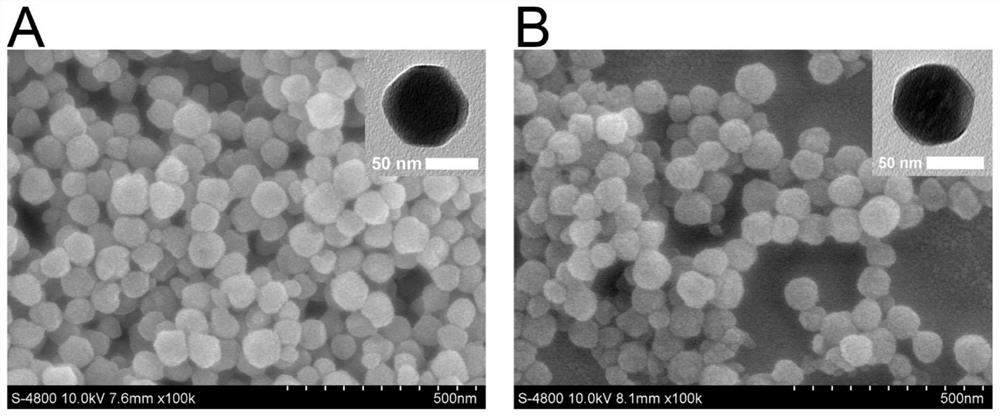Fluorescent probe, enhanced ratio fluorescence sensor, method and application
A fluorescent probe and ratiometric fluorescence technology, which is applied in the field of fluorescence detection, can solve the problems of no fluorescence fluorescence performance, achieve accuracy and anti-interference ability, facilitate visual detection, and eliminate system errors.
- Summary
- Abstract
- Description
- Claims
- Application Information
AI Technical Summary
Problems solved by technology
Method used
Image
Examples
Embodiment 1
[0048] Following the above-mentioned technical scheme, the present embodiment provides a kind of fluorescent probe, which is used to detect tetracycline antibiotics. Prepared by reaction in aqueous solution of hydrate;
[0049] The prepared fluorescent probe has a red fluorescent emission peak at a wavelength of 604nm, and produces a green fluorescent emission peak at a wavelength of 512nm for tetracycline antibiotics, and the particle size of the fluorescent probe is 73-83nm. Fluorescent probes interact with tetracycline antibiotics to generate new emission peaks.
[0050] It specifically comprises the following steps: respectively dissolving zinc nitrate and 2-methylimidazole in methanol, then mixing them, stirring continuously for 1 hour, washing the precipitate with methanol for 3 times, and then performing vacuum freeze-drying to obtain ZIF-8, wherein The molar ratio of zinc ion and 2-methylimidazole is 1:70; the Ru(bpy) 3 2+ Dissolve in ultrapure water, and adjust the...
Embodiment 2
[0061] This embodiment provides an enhanced ratiometric fluorescence sensor and its preparation method. The enhanced ratiometric fluorescence sensor includes the fluorescent probe described in Example 1, comprising the following steps:
[0062] Step 1: The methanol solution dissolved in zinc nitrate and the methanol solution dissolved in 2-methylimidazole are mixed and stirred for reaction to obtain a precipitate, which is the zeolite imidazolate skeleton ZIF-8;
[0063] Step 2: dissolving terpyridine ruthenium chloride hexahydrate in water, and adjusting the pH of the resulting solution with sodium hydroxide; adjusting the pH is to facilitate complexing with ZIF-8;
[0064] The concentration of the solution obtained by dissolving terpyridine ruthenium chloride hexahydrate in water is (3-6) mg / mL, the initial pH of the solution is 8-8.3, and the pH of the solution is adjusted to 12 by using sodium hydroxide.
[0065] Step 3: Precipitate the zeolite imidazolate skeleton ZIF-8 o...
Embodiment 3
[0071] This example verifies the feasibility and specificity of the enhanced ratiometric fluorescent sensor prepared in Example 2 for detecting tetracycline antibiotics.
[0072] Taking tetracycline (TET) as the representative of tetracycline antibiotics, the feasibility test of enhanced ratiometric fluorescent sensor for detection of tetracycline antibiotics is carried out. The specific experimental operations are as follows:
[0073] Put 100 μL ZIF-8 solution in a 2 mL centrifuge tube, add 1 μL tetracycline standard solution with a concentration of 10 mM, dilute to 1 mL with ultrapure water, mix and react for 3 minutes, as control group 1;
[0074] Put 100 μL of the Ru@ZIF-8 solution in Example 2 into a 2 mL centrifuge tube, and dilute it to 1 mL with ultrapure water, as control group 2;
[0075] Put 100 μL of the Ru@ZIF-8 solution in Example 2 into a 2 mL centrifuge tube, add 1 μL of tetracycline standard solution with a concentration of 10 mM, dilute to 1 mL with ultrapure...
PUM
| Property | Measurement | Unit |
|---|---|---|
| particle diameter | aaaaa | aaaaa |
| concentration | aaaaa | aaaaa |
| particle diameter | aaaaa | aaaaa |
Abstract
Description
Claims
Application Information
 Login to View More
Login to View More - Generate Ideas
- Intellectual Property
- Life Sciences
- Materials
- Tech Scout
- Unparalleled Data Quality
- Higher Quality Content
- 60% Fewer Hallucinations
Browse by: Latest US Patents, China's latest patents, Technical Efficacy Thesaurus, Application Domain, Technology Topic, Popular Technical Reports.
© 2025 PatSnap. All rights reserved.Legal|Privacy policy|Modern Slavery Act Transparency Statement|Sitemap|About US| Contact US: help@patsnap.com



